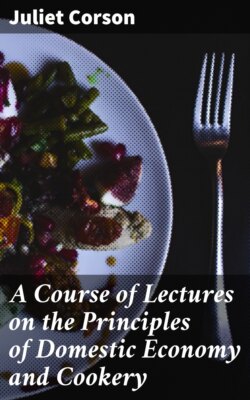Читать книгу A Course of Lectures on the Principles of Domestic Economy and Cookery - Juliet Corson - Страница 12
LECTURE SECOND.
ОглавлениеOur lesson this afternoon will consist of some plain soups and stews of meat. I shall begin with a soup—of yellow split peas. For four quarts of soup use an ordinary cupful of yellow split peas; pick them over and wash them in cold water, put them in a saucepan or a soup kettle with two quarts of cold water. Set the saucepan or soup kettle over the fire and let the water very gradually heat. When it boils put in some cold water—part of a cupful, let them boil again; keep on putting in cold water every fifteen or twenty minutes, until you have used two quarts of cold water besides the first two quarts. The object of adding cold water slowly is this: You soften the peas by the gradual heating of the cold water. After the first boiling the addition of a little cold water lowers the temperature, and as the water heats again the peas are gradually softening; so that within an hour and a half or two hours you will find them quite tender enough. You will notice that I have used no salt; the salt would tend to harden the peas. You add salt after the soup is nearly finished. The old way of soaking the peas over night is a very good one, but this is rather better, for this reason: If you soak the peas over night you destroy a small portion of their nutritive properties; especially if you make the soup in warm water, there will be a slight fermentation. The object of soaking them over night is simply to soften them, and as you can soften them in this way you accomplish the same purpose by adding cold water gradually. You will notice that this is for perfectly plain pea soup. You can vary it by adding bones of cold ham, or of cold roast beef; you can boil the bones with the peas. In that way you get the flavor of whatever meat you add. A very nice soup is made simply with the peas without any meat, by the addition of a fried onion, for that soup you would peel and slice an onion and put it in the bottom of the soup kettle with a tablespoonful of butter or drippings—beef drippings or poultry drippings—and fry it light brown; then put on the peas and cold water and proceed just as we do to-day for a plain pea soup, without any addition except a seasoning of salt and pepper, and by and by a little flour and butter, which I shall put in at the close, the object of which I will explain to you then.
